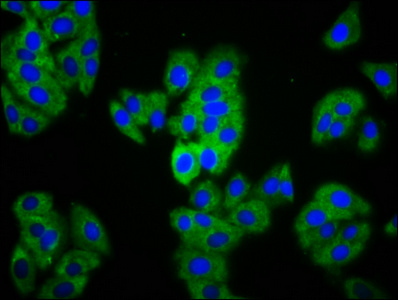MAGI1 antibody
GTX11473
ApplicationsWestern Blot
Product group Antibodies
TargetMAGI1
Overview
- SupplierGeneTex
- Product NameMAGI1 antibody
- Delivery Days Customer9
- Application Supplier NoteWB: 1:500. *Optimal dilutions/concentrations should be determined by the researcher.Not tested in other applications.
- ApplicationsWestern Blot
- CertificationResearch Use Only
- ClonalityPolyclonal
- ConjugateUnconjugated
- Gene ID9223
- Target nameMAGI1
- Target descriptionmembrane associated guanylate kinase, WW and PDZ domain containing 1
- Target synonymsAIP-3, AIP3, BAIAP1, BAP-1, BAP1, MAGI-1, MAGI-1b, Magi1d, TNRC19, WWP3, membrane-associated guanylate kinase, WW and PDZ domain-containing protein 1, BAI1-associated protein 1, WW domain-containing protein 3, atrophin-1-interacting protein 3, membrane-associated guanylate kinase inverted 1, trinucleotide repeat-containing gene 19 protein
- HostRabbit
- IsotypeIgG
- Protein IDQ96QZ7
- Protein NameMembrane-associated guanylate kinase, WW and PDZ domain-containing protein 1
- Scientific DescriptionThe MAGUK (Membrane-Associated Guanylate Kinase) family of proteins is characterized by the presence of multi-PDZ and SH3 domains, and a single region of homology to Saccharomyces cerevisiae guanylate kinase (GuK) domain. All MAGUKs studied to date localize to regions of cell-cell contact such as tight junctions in epithelial cells and synaptic junctions in neurons and are believed to be involved in the assembly of multi-protein complexes via their protein-protein interaction domains. Three novel, closely related MAGUK proteins were isolated by means of different screening assays, and named MAGI1/BAP1, MAGI2/ S-SCAM /ARIP, and SLIPR/MAGI3. MAGI1 was first identified in mouse as a protein interacting with K-RasB. Three isoforms were identified, and named MAGI1a, MAGI1b, and MAGI1c, of 1139, 1171, and 1374 amino acids respectively. The isolation of a growing number of MAGI1 binding partners, together with the determination of the subcellular and tissue distribution of the different isoforms, are paving the way towards elucidation of its function.
- Storage Instruction-20°C or -80°C,2°C to 8°C
- UNSPSC12352203



